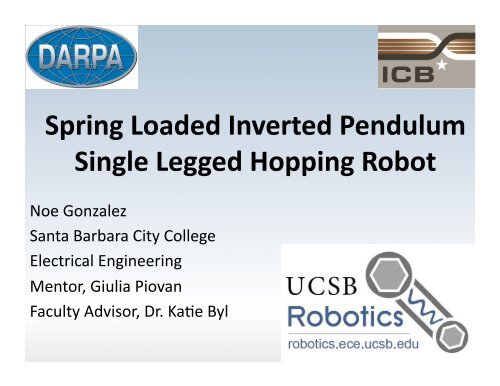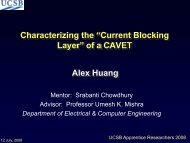Spring Loaded Inverted Pendulum Single Legged Hopping Robot
Spring Loaded Inverted Pendulum Single Legged Hopping Robot
Spring Loaded Inverted Pendulum Single Legged Hopping Robot
You also want an ePaper? Increase the reach of your titles
YUMPU automatically turns print PDFs into web optimized ePapers that Google loves.
<strong>Spring</strong> <strong>Loaded</strong> <strong>Inverted</strong> <strong>Pendulum</strong><br />
<strong>Single</strong> <strong>Legged</strong> <strong>Hopping</strong> <strong>Robot</strong><br />
Noe Gonzalez<br />
Santa Barbara City College<br />
Electrical Engineering<br />
Mentor, Giulia Piovan<br />
Faculty Advisor, Dr. KaAe Byl
A New Generation of <strong>Robot</strong>s <br />
M3 Program(DARPA)<br />
• Maximum Mobility<br />
& ManipulaAon<br />
• CreaAon & Enhancement<br />
• Jointed & <strong>Legged</strong> bots<br />
• Natural Environments<br />
Focus on Rough Terrain<br />
Unmanned<br />
Military OperaEons<br />
• TransportaAon of Supplies & Equipment<br />
• EvacuaAon of Injured personnel<br />
• ExploraAon of remote and hazardous areas<br />
• Search and rescue<br />
• Advanced ScouAng<br />
(Image from hOp://www.bostondynamics.com/)
<strong>Spring</strong>-<strong>Loaded</strong> <strong>Inverted</strong> <strong>Pendulum</strong>(SLIP)<br />
Model<br />
Goal: To simulate a real & successful trajectory on<br />
rough terrain of the model using Matlab.<br />
Apex State: Highest Point
Defining the SLIP Model EquaAons<br />
Fixed Variables<br />
m=1 kg<br />
L0= 1 m<br />
k= 106 N/m<br />
Vary (dx, y)
Height (m)<br />
IniAal CondiAons:<br />
x = 0<br />
y = 1.57 m<br />
dx = 6.57 m/s<br />
Distance traveled (m)
For each set of points (dx, y), we know<br />
the degree span we can use<br />
Height (m)<br />
Forward velocity, dx (m/s)
LocaAng point on known grid<br />
• Locate random point<br />
between 4 known points for<br />
which we know the angle<br />
range for (.05 intervals)<br />
y<br />
P(dx,y) = (6.54, 1.57)<br />
dx<br />
• Choose the middle point of<br />
the range in order to have an<br />
angle that will allow a<br />
successful jump.
Angle span with respect to an iniAal height and velocity<br />
IniAal apex height y (m)<br />
P(dx,y)<br />
Degree span<br />
IniAal forward velocity dx (m/s)
Height = 1.57 (m)<br />
Velocity = 6.54 (m/s)
Angle span with respect to an iniAal height and velocity<br />
IniAal apex height y (m)<br />
P(dx,y) = (7.99, 2.01)<br />
No SoluAon<br />
P(dx,y)<br />
Degree Span<br />
IniAal forward velocity dx (m/s)
Gaussian normal distribuAon on<br />
sensor error<br />
IniAal apex height y (m)<br />
IniAal forward velocity dx (m/s)<br />
The farther the point is, the less<br />
consideraAon we take of that point<br />
since it’s unlikely to be real.
RelaAve to the Big Picture<br />
• Implement SLIP model<br />
to biped and quadruped<br />
robots to give ability to<br />
run or jump when<br />
needed.
Summary<br />
• Defined equaAons of moAon<br />
• Constructed a look up table that shows angle range<br />
for specific set of points<br />
• Model successful and unsuccessful jumps<br />
• Used a Gaussian normal distribuAon to distribute the<br />
error percentage that we may encounter<br />
• Video clips of the model
Thank You<br />
INSET: For the opportunity to be part of this great<br />
program: Dr. Nick Arnold, Jens Kuhn<br />
Giulia Piovan: For being a great mentor<br />
Dr. KaEe Byl: For allowing me to work on her<br />
amazing lab<br />
CrisEna Luna: For your conAnuous support, I love<br />
you<br />
MESA/SHPE: For coming out and supporAng<br />
Virginia Estrella: For all of your great and wise<br />
guidance
Future Work:<br />
Implement an actuator<br />
to leg in order to add<br />
energy to the trajectory<br />
so that it can overcome<br />
big obstacles.














